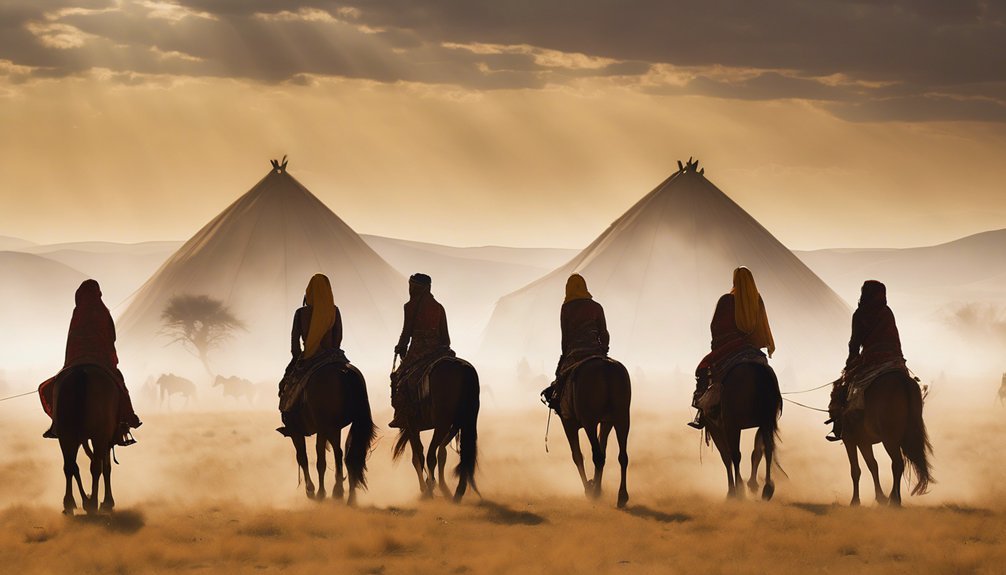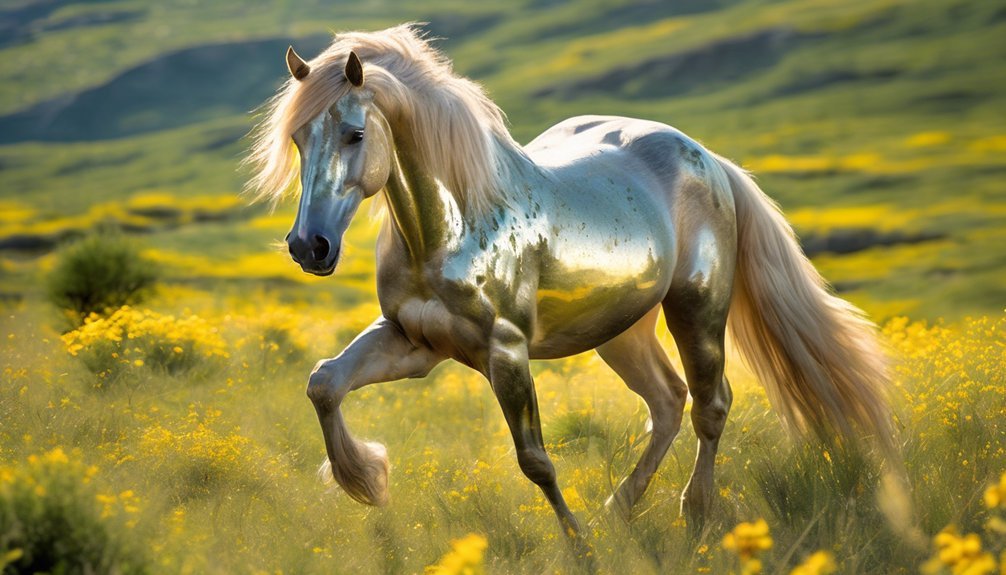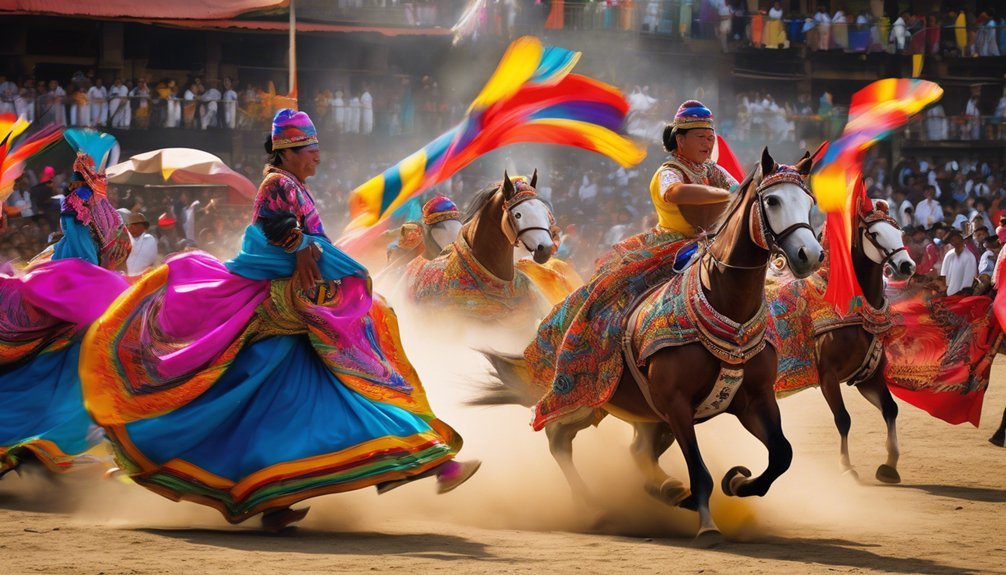
In nomadic cultures, horses are more than just animals; they're vital companions that shape lifestyles and identities. They enhance mobility, facilitating trade and communication across vast terrains. Their role extends beyond transportation, influencing economic practices and cultural rituals. As you explore the intricate connections between these majestic creatures and the people who rely on them, you'll uncover how deeply intertwined their fates truly are. What does this enduring bond reveal about the future of nomadic traditions?
Key Takeaways
- Horses symbolize strength, resilience, and freedom, deeply intertwined with the cultural identity of nomadic peoples.
- They facilitate transportation, trade, and communication, linking diverse communities across vast landscapes.
- Horses play a central role in rituals and ceremonies, fostering emotional connections and community cohesion.
- Specialized breeds have adapted to nomadic lifestyles, thriving on limited resources and forming deep bonds with caretakers.
- Despite modernization, horses remain vital to nomadic cultures, balancing tradition with contemporary practices in their care and management.
The Historical Significance of Horses in Nomadic Societies

While many cultures have relied on animals for survival, horses hold a unique place in nomadic societies, shaping their way of life in profound ways.
The domestication of horses transformed your ancestors' existence, allowing them to travel vast distances, hunt more efficiently, and trade with neighboring groups. With each gallop, horses became symbols of strength and resilience, embodying the spirit of freedom inherent in nomadic lifestyles.
Their ability to adapt to diverse terrains mirrored the versatility of those who rode them. Beyond practical purposes, horses also fostered deep social bonds and cultural identities, enriching spiritual beliefs and communal rituals.
In this intricate dance of dependency and companionship, horses weren't just animals; they were lifelines that sustained and defined entire ways of living.
Horses as a Means of Transportation and Mobility
Horses have shaped the way nomadic cultures navigate their vast landscapes, serving as essential vehicles for movement and exploration.
You can see how these magnificent animals facilitated trade and communication, linking communities and fostering relationships across great distances.
In this context, horses embody not just a means of transport but also a vital element of cultural identity and heritage.
Historical Significance of Mobility
As nomadic cultures traversed vast landscapes, the role of horses as a means of transportation became pivotal in shaping their way of life.
These majestic creatures facilitated historical mobility, allowing tribes to adapt to changing environments and seasons.
Picture yourself riding alongside your kin, feeling the wind whip past as your horse gallops across open plains.
This mobility wasn't just about speed; it embodied freedom and survival during nomadic migrations.
You could seek fresh pastures, water sources, or evade dangers, all thanks to your trusty steed.
Horses became symbols of status and strength, intertwining with the very identity of these cultures.
You can almost hear the stories of resilience echoing through generations, as horses transformed the dynamics of movement and connection within their world.
Trade and Communication Routes
When nomadic tribes harnessed the power of horses, they not only enhanced their mobility but also established vital trade and communication routes across vast distances.
These routes became lifelines, connecting disparate groups and facilitating the exchange of goods, ideas, and cultures.
Imagine the rhythmic thump of hooves on the earth, as traders traversed rugged terrains, carrying precious commodities like textiles and spices.
Horses transformed the landscape into a web of communication networks, enabling swift messages to flow between tribes.
This mobility fostered relationships, strengthened alliances, and nurtured a sense of community.
The horse, in this context, wasn't just a means of transportation; it was a bridge, linking lives and livelihoods in a rich tapestry of human connection and trade.
Cultural Identity and Heritage
In nomadic cultures, the bond between people and their horses shapes not just daily life but also cultural identity and heritage.
Horses symbolize freedom and mobility, embodying the spirit of wanderers. As you traverse vast landscapes, each hoofbeat tells a story, weaving your experiences into the rich tapestry of cultural narratives.
The way you care for and ride your horse reflects shared traditions, reinforcing community ties and ancestral legacies. Through ceremonies and storytelling, horse symbolism transcends mere transportation; it becomes a vital thread connecting generations.
The horse isn't just a means to travel; it's a living emblem of your people's resilience and adaptability, capturing the essence of a nomadic life steeped in history and identity.
The Economic Impact of Horses on Trade and Resource Acquisition
Horses have fundamentally transformed trade and resource acquisition within nomadic cultures, allowing communities to traverse vast landscapes with unprecedented efficiency.
You'll find that horses enable not just transportation but also vital connections between groups. Their role in horse trade opens doors for resource exchange, fostering relationships that strengthen communal bonds.
- Increased mobility leads to broader trade networks.
- Horses serve as currency, enhancing resource value.
- Efficient transport of goods reduces time and risk.
Horses in Cultural Practices and Rituals

In nomadic cultures, horses aren't just means of transport; they're central to ceremonial rites that mark significant life events.
You'll notice their powerful symbolism in art, reflecting values such as strength and freedom.
Additionally, traditional horse games showcase the bond between rider and horse, highlighting their importance in community identity and cohesion.
Horses in Ceremonial Rites
While many cultures embrace horses as symbols of power and freedom, their roles in ceremonial rites reveal deeper connections to identity and spirituality.
You'll find that within these rituals, horses embody more than just physical presence; they carry profound ceremonial significance. They often serve as the bridge between the earthly and the divine, fostering a sense of community and continuity among participants.
- Horses in rituals are often adorned with special attire, enhancing their sacred role.
- They may accompany important life events, such as weddings or funerals, marking significant transitions.
- Rituals involving horses often include music and dance, creating an immersive experience for all involved.
Through these practices, you can appreciate how horses enrich cultural narratives and affirm shared beliefs.
Symbolism in Art
Art serves as a powerful medium through which the profound symbolism of horses in cultural practices and rituals is expressed.
You'll find that horses often embody strength, freedom, and the connection between the earthly and the divine. Through mythical representations, artists capture the essence of horses, illustrating their significance in storytelling and spiritual beliefs.
These artistic expressions, be it through paintings, sculptures, or textiles, reflect the deep reverence nomadic cultures hold for these majestic creatures. Each brushstroke or weave resonates with the horse's role in community identity, showcasing both their physical prowess and spiritual essence.
As you explore these artworks, you'll feel the intimate bond shared between horses and the nomadic way of life, transcending time and culture.
Traditional Horse Games
Traditional horse games play a vital role in the cultural fabric of nomadic societies, showcasing not just skill and athleticism but also deep-seated traditions and values.
These vibrant activities, often highlighted during equestrian festivals, create a sense of community and shared heritage. You can witness the excitement of traditional racing, where speed and strategy intertwine, bringing families and tribes together.
- Cultural Heritage: Each game reflects the history and stories of a people.
- Community Bonding: Participants and spectators unite, fostering camaraderie.
- Skill Development: Riders hone their abilities, passing down techniques through generations.
Engaging in these games, you not only experience the thrill but also connect with a legacy that transcends time, enriching the soul of every participant.
The Bond Between Horses and Their Human Companions
As you observe the intricate relationship between nomadic cultures and their horses, it becomes clear that this bond transcends mere utility; it embodies a deep emotional connection.
The moments shared during bonding rituals, like gentle grooming or quiet companionship under the stars, create a profound sense of trust. You can see how human and horse communicate through subtle gestures, each respecting the other's space and needs.
This mutual respect fosters a partnership that goes beyond survival; it becomes a source of comfort and joy in often harsh environments.
When you witness a nomad whispering to their horse, you understand that this relationship is built on love and understanding, a testament to the enduring spirit of both horse and human.
Equine Breeds and Their Adaptations to Nomadic Lifestyles
The bond between nomadic cultures and their horses shapes not only their companionship but also the characteristics of the equine breeds they rely on.
These specialized breeds have developed adaptive traits that make them perfect partners for a mobile lifestyle. You'll notice how their stamina, resilience, and unique temperaments align with the demands of their human companions.
- Stamina: Essential for long journeys across diverse terrains.
- Resilience: Ability to thrive on limited resources, adapting to harsh environments.
- Unique Temperaments: Gentle yet spirited, fostering deep connections with their caretakers.
Understanding these specialized breeds and their adaptive traits reveals the profound relationship between nomads and their horses, illustrating how both have evolved together in harmony.
The Future of Horses in Modern Nomadic Cultures

While many nomadic cultures have faced significant changes due to modernization, horses remain a vital part of their identity and way of life.
As you observe these communities, you'll see how they embrace sustainable practices, ensuring their horses thrive alongside their evolving environment.
Modern adaptations, like integrating technology for tracking and health management, allow nomads to maintain a deep connection with their equine companions while navigating contemporary challenges.
You'll notice that horses continue to symbolize freedom, resilience, and tradition, even as these cultures adapt to urban influences.
The future of horses in these settings lies in balancing age-old customs with innovative solutions, fostering a harmonious relationship that honors the past while embracing new possibilities.
Frequently Asked Questions
How Do Nomadic Cultures Select Horses for Their Herds?
When you select horses for your herd, you consider breed selection carefully, assessing traits like endurance and temperament. Effective herd management ensures your horses thrive, providing companionship, labor, and resilience in your nomadic lifestyle.
What Challenges Do Horses Face in Harsh Nomadic Environments?
Imagine a horse navigating a barren landscape, struggling for sustenance sources. In harsh nomadic environments, they face extreme weather, limited food, and water scarcity, forcing them to adapt quickly to survive and thrive.
How Do Horses Influence Social Structures in Nomadic Groups?
Horses shape your group's social hierarchies, influencing herd dynamics. As you bond with these majestic creatures, their presence fosters connections and loyalty, creating a unique tapestry of relationships that defines your nomadic community's identity.
What Is the Role of Women in Horse Care Among Nomads?
Women embody the heart of nomadic life, nurturing horses with care. Their responsibilities intertwine with traditional practices, ensuring these majestic creatures thrive, reflecting both strength and grace. You'll find their influence vital in every galloping step.
How Are Horses Trained Differently in Nomadic Cultures?
In nomadic cultures, you'll find horses trained through natural horsemanship, emphasizing trust and connection. Instead of conventional saddle training, you cultivate a deep bond, allowing horses to respond intuitively to your guidance and environment.
Conclusion
In the tapestry of nomadic cultures, horses weave threads of history, identity, and survival, much like the stars guide travelers through the night. Their significance transcends mere utility; they embody the spirit of resilience and connection that defines these vibrant communities. As modernity encroaches, the bond between horses and their human companions remains a vital lifeline, ensuring that traditions endure. By valuing this relationship, you help preserve a way of life that's as rich and dynamic as the landscapes they traverse.





